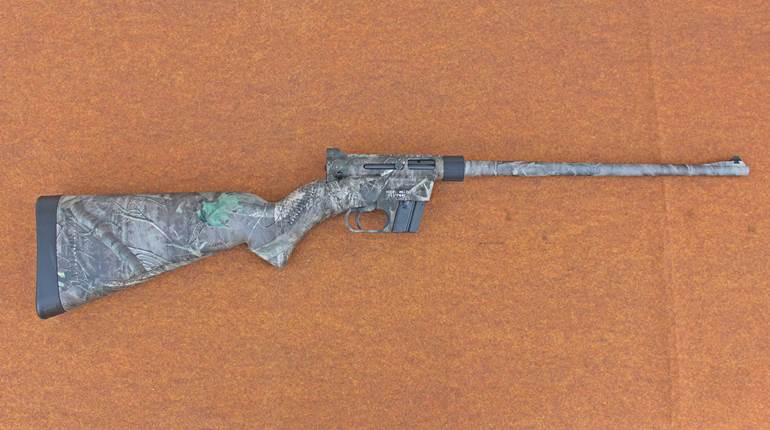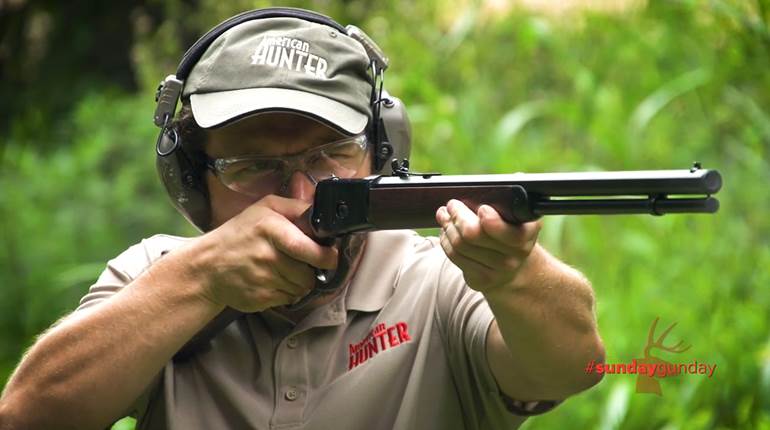
If you see me walking the floors of a trade show, like the annual SHOT Show held in Las Vegas, don't be surprised if I enthusiastically swerve off the wide carpeted paths to handle the Old West-style firearms like those offered by Cimarron F. A. Co. Some folks believe that high-quality replicas of the cartridge-firing wheel and lever guns of the late 1800s are just for history buffs and cowboy action shooting competitions. In truth, these guns are some of the most fun and satisfying models to run on the range or carry in the field. Don't let the patent dates on the frames fool you; those designers knew what they were doing.

When I picked up the Cimarron Bad Boy for the first time, it came as no surprise that my hands liked holding it. The Bad Boy is not an exact replica of a particular historical single-action revolver. Instead, the engineers of A. Uberti, Srl. of Italy, who designed and produced it for Cimarron's catalog, gave this model a cleverly blended set of features from different time periods which successfully preserve the heirloom look and feel of a period piece while making it a handy field gun. The result is a handsome single-action with excellent balance and a smooth action.

Constructed wholly of deeply blued carbon steel, the flat-top 3-screw receiver is paired with a pre-war grip frame which takes its cues from the Colt 1860 Army model. This means the grip frame is longer to provide more support for the shooting hand. This model is available with either an 8" or 6" octagonal barrel. Even though the 8" barrel version of the Bad Boy exhibited a superb degree of balance, I opted to work with the 6" barrel because it's a bit easier to pack around.

The left side of the barrel is lightly engraved with “Bad Boy” and “44 Mag.” Thankfully, this engraving is minimal and does not distract from the lines of the gun. The typically narrow fixed front blade sight has been replaced with a much more modern dovetailed target sight with a serrated ramp. The squared-off rear sight is fully adjustable for height and windage. The full-length, spring-loaded ejector is protected by a blued steel housing.

The 6-shot cylinder, which can safely chamber both .44 Mag. and .44 Spl. cartridges (along with .44 Russian, if you can find it), is unfluted and fits tightly up against the frame. This means that unlike a double-action revolver, where the cartridge rims are usually visible in between the cylinder and the frame, the Bad Boy's chambers are only visible through the right-side loading gate. The cylinder pin has a short, grooved knob and is secured to the frame by a spring-loaded retainer pin.

The case-hardened hammer has an elegantly curved and textured spur for easy cocking with the firing pin mounted directly to it (more on this later). Because this revolver is a single-action, it must be manually cocked for each shot fired. The smooth, narrow steel-bow trigger is housed within a traditional, rounded trigger guard which is integral to the one-piece steel grip frame. The grip frame is nicely topped off with a pair of smooth walnut grip panels which have been polished and lacquered for a glossy finish.

The Bad Boy's hammer has three positions: forward, half-cocked and fully cocked. Because the firing pin is mounted directly to the hammer, which is the original configuration for this type of gun, it will come into contact with the cartridge primer when the hammer is in the forward position. This means the revolver should not be carried with a round under the hammer because a bump or drop is likely to cause the gun to go off.

The traditional method for loading just five chambers for safety is to load the first chamber, skip a chamber, then load the remaining four. This allows the empty chamber to rotate under the hammer when the fifth round is loaded. Some folks say that all revolvers should have transfer-bar safeties to prevent unintentional discharges while others say this kind of safety spoils the look and feel of period reproductions. My advice is to learn to run the guns you have and make sure the safety system located between your ears is fully activated before handling any firearm.

I have yet to shoot a .44 Mag. that didn't exhibit plenty of get-up-and-go in the felt recoil department when firing full-power rounds. This is why the longer Army grip frame is such a good fit for this model. It provides a full 3-finger grip while rolling back in the hand to help mitigate the stiff kick. Firing .44 Spl. ammunition, including soft-shooting cowboy loads up to defense-grade hollow points, generates a much more tame shooting experience akin to working with a revolver chambered in .45 Colt.

The Uberti revolvers I've worked with in the past exhibited clean, crisp actions with smooth operations and definitive “clicks” in the hammers and cylinders when appropriate. The Bad Boy was no exception. The fit, finish and overall craftsmanship were excellent. All of the controls worked flawlessly and the gun did not exhibit any hiccups, hang-ups or malfunctions throughout the course of formal and informal testing.

Hornady kindly provided the three factory loads used for formal benchrested accuracy testing at 25 yards. I opted for two defense-grade .44 Spl. rounds and one of my favorite multi-purpose .44 Mag. cartridges. The Critical Defense .44 Spl. 165-gr. FTX load tapped out a best single 5-shot group of 2.44" with a five-group average of 2.63". The Custom .44 Spl. 180-gr. XTP printed a best group of 2.39" with an average of 2.56". The Lever Evolution .44 Mag. 225 FTX produced a best group of 2.71" with an average of 2.88".

The Cimarron Bad Boy is a ready-to-work .44 Mag. intended for handgun hunting and defense against dangerous game while on the trail. Nevertheless, it's a handsome piece with the desirable handling characteristics and charm exemplified by late 19th century single-action revolvers. With real-world prices under $600, the Bad Boy is a good buy for cowboy-style shooting enthusiasts and selective eclectics who enjoy guns that are reliable and fun to shoot.

Specifications:
U.S. Distributor: Cimarron F.A. Co.
Manufacturer: Uberti
Model: Bad Boy
Action: Single-Action Revolver
Caliber: .44 Mag./.44 Spl.
Finish: Blued Steel
Barrel: 6" Octagonal, 8” Available
Front Sight: Dovetailed Target
Rear Sight: Adjustable Target
Cylinder: Unfluted
Grip Frame: Pre-War
Grip Panels: Smooth Walnut
Trigger Pull: 2 lbs. 9 oz. (as tested)
Overall Length: 11”
Cylinder Width: 1.70”
Weight: 41 oz. Unloaded
Capacity: Six Rounds
Accessories: Owner's Manual
MSRP: $687




































